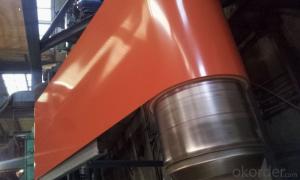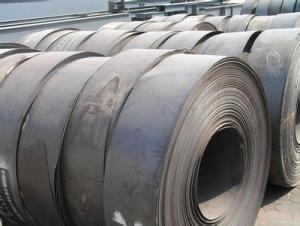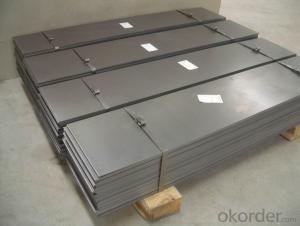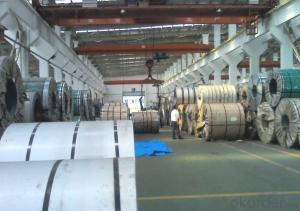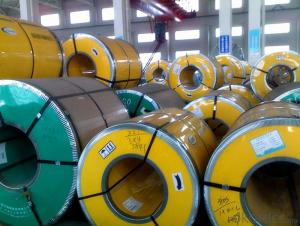prepainted steel coil JIS G 3312
- Loading Port:
- China Main Port
- Payment Terms:
- TT OR LC
- Min Order Qty:
- -
- Supply Capability:
- -
OKorder Service Pledge
OKorder Financial Service
You Might Also Like
PREPAINTED STEEL COIL
Packaging & Delivery
Packaging Detail: seaworthy export package
Delivery Detail: on request
Specifications
1. more than 10 years’ experience on this field
2. advanced equipments
3. competitive price
4. soonest delivery
Product Description :
Commodity
PREPAINTED STEEL COIL
Technical Standard: JIS 3312
Grade:CGCC
Types:Commercial / Drawing / Deep Drawing / Structural quality
Width: 900mm/1000mm/1219mm/1200mm/1220mm/1250mm
Thickness: 0.2mm~4.0mm
Type of coating: galvanized
Zinc coating: Z40-275g/m2,Z40-Z450g/m2
ID coil: 508mm or 610mm
Coil weight: 3-10/MT per coil
Package:Properly packed for ocean freight exportation in 20''container
Application::home appliances, constructions, building, machineries
Our Advantages :
1. Expertise:
More than 10 years of manufacture: we know how to properly handle every step of production.
2. Competitive price:
We can offer competitive prices to our customers.
3. Accuracy:
We have excellent technicians and leaders, which can ensure our products are exactly what you want.
4. Materials:
All galvanized steel coils are made of high-quality raw materials.
5. Certificate:
Our products are certified by ISO9001.
6. Productivity:
We have large-scales of production lines,, which can guarantee all your orders will be finished in earliest time.
Hr CGL Technical Process:
Coil loading-> uncoiling-> cutting-> welding-> entry accumulator-> Heating and deoxidization-> galvanizing-> air cooling->water quenching-> air dryer-> tension leveler-> Passivation->air dryer->exit accumulator-> oiling-> cutting-> recoiling->coil unloading-> packing
The furnace heating style: improved Sendzimir heating technology
Hourly output: max.76.3t/h
Process after coating: tension leveling, Passivation or oiling
Our Service
Our quality
Test Equipments of Prepainted Galvanized Steel Coil : Salt-spray tester; Atomic absorption spectrophotometer; Rockwell typer hardness tester; Tensile test machine; Metrohm titration; Laboratory Bend test machine.
Our packing
Properly packed for ocean freight exportation in 20''container, galvanized metal fluted rings on inner and outer edges, galvanized metal & waterproof paper wall protection disk, galvanized metal & waterproof paper around circumference.
R&D department
R&D department concentrates on researching and developing reliable products with best quality. The quality department test and control every process of production to guarantee the best quality of product
- Q:Are steel strips used in the production of shipping containers?
- Yes, steel strips are commonly used in the production of shipping containers. Steel is known for its strength and durability, making it an ideal material for constructing containers that can withstand the rigors of transportation and protect the goods inside. Steel strips are often used to form the structural framework of the container, providing stability and support. Additionally, steel strips are also used for reinforcing the corners and edges of the container, as these areas are more susceptible to damage. Overall, the use of steel strips in the production of shipping containers ensures that the containers are strong, secure, and capable of withstanding the demands of the shipping industry.
- Q:Can steel strips be used for making architectural panels?
- Yes, steel strips can definitely be used for making architectural panels. Steel is a versatile and durable material that is well-suited for architectural applications. Steel strips can be cut and shaped into various sizes and forms, making them ideal for creating architectural panels with different designs and patterns. Additionally, steel panels offer several advantages such as strength, fire resistance, and low maintenance, making them a popular choice for architectural projects. They can be used in a wide range of applications including exterior cladding, interior wall panels, roofing systems, and decorative features. The steel panels can also be treated with various finishes and coatings to enhance their aesthetic appeal and protect them from corrosion, further expanding their usability in architectural projects. Overall, steel strips provide a reliable and aesthetically pleasing option for creating architectural panels.
- Q:What are the specifications for steel strips used in the production of fasteners?
- The production of fasteners requires steel strips with varying specifications, depending on the specific application and requirements. However, there are some common specifications for these steel strips: 1. Material: Typically, mild steel, also known as low carbon steel, is used for fastener production. This type of steel is cost-effective and offers good strength and ductility. 2. Dimensions: Steel strips for fasteners are usually supplied in coils or cut-to-length strips. The strip width can range from a few millimeters to several centimeters, depending on the size of the fasteners being produced. The strip thickness also varies based on the specific application and requirements. 3. Surface Finish: Steel strips used in fastener production often undergo surface treatments to enhance their corrosion resistance and appearance. Common surface finishes include zinc plating, galvanizing, or applying protective coatings like phosphate or black oxide. 4. Tensile Strength: The steel strip's tensile strength is a crucial specification as it determines the maximum load the fastener can withstand without breaking or deforming. The specific tensile strength requirement depends on the application and the type of fastener being produced. 5. Hardness: The hardness of the steel strip measures its resistance to indentation or deformation. Different fasteners may require different hardness levels to ensure they can withstand their intended application without failure. 6. Composition and Chemical Properties: Steel strips used in fastener production must meet specific chemical composition requirements to ensure desired mechanical properties. The levels of carbon, manganese, sulfur, phosphorus, and other elements are controlled to achieve the desired strength, ductility, and other performance characteristics. It is important to note that these specifications can vary depending on the specific standards and regulations followed in different industries or regions. Therefore, consulting relevant industry standards or the manufacturer's specifications is advisable for precise details about the steel strips used in fastener production.
- Q:How are steel strips annealed for improved ductility?
- Steel strips are annealed for improved ductility by heating them to a specific temperature and then slowly cooling them. This process helps to relieve internal stresses and refine the microstructure of the steel, making it more flexible and less prone to cracking or breaking.
- Q:How do steel strips contribute to chemical resistance in various applications?
- Steel strips contribute to chemical resistance in various applications due to their inherent properties. Steel is a strong and durable material that can withstand exposure to corrosive chemicals, acids, and bases, making it highly resistant to chemical reactions. Additionally, steel strips can be coated with protective layers or alloys, such as stainless steel or galvanization, which further enhance their resistance to chemical corrosion. This makes steel strips an ideal choice for applications where chemical exposure is a concern, ensuring the longevity and reliability of the product.
- Q:How are steel strips used in the production of elevator components?
- Due to their strength, durability, and versatility, steel strips find widespread application in the manufacturing of elevator components. Elevator guide rails, for instance, heavily rely on these strips as they provide essential support and guidance for the elevator car and counterweight, guaranteeing a smooth and secure movement. To construct the base structure of the guide rails, steel strips are meticulously designed and manufactured from high-quality steel capable of enduring the immense loads and continuous usage experienced by elevator systems. Moreover, steel strips are employed in the production of various other elevator components, including brackets, which are responsible for securely holding different parts of the elevator system together, ensuring stability and reliability. The strips offer the necessary strength and rigidity to bear the weight of the elevator car, counterweight, and other moving elements. Additionally, steel strips are custom-made and shaped to fit the specific dimensions and design requirements of elevator doors. These strips serve as the frame or reinforcement for the door panels, imparting strength and stability while permitting seamless opening and closing. In conclusion, the utilization of steel strips is of paramount importance in the manufacturing of elevator components. Their exceptional strength, durability, and stability enable elevator systems to withstand the rigors of heavy loads, constant usage, and various forces encountered in vertical transportation.
- Q:How are steel strips used in the manufacturing of kitchenware?
- Steel strips are commonly used in the manufacturing of kitchenware due to their versatility, durability, and ease of manipulation. These strips of steel serve as the primary material for various kitchen utensils and appliances, including pots, pans, cutlery, and baking trays. One of the key uses of steel strips in kitchenware manufacturing is for shaping and forming the desired product. Steel strips can be easily cut, bent, and molded into different shapes and sizes, allowing manufacturers to create a wide range of kitchen utensils with different functional purposes. The flexibility of steel strips enables the production of intricate designs and details, ensuring that the final product meets both aesthetic and functional requirements. Additionally, steel strips provide excellent heat conductivity, making them ideal for cookware. They efficiently distribute heat evenly across the surface, ensuring that food is cooked uniformly. This property is particularly important for pots and pans, as it prevents hotspots and allows for precise temperature control during cooking. Furthermore, steel strips used in kitchenware are typically coated with non-stick materials such as Teflon or ceramic. This coating ensures that food does not stick to the surface, making cooking and cleaning easier. It also prevents the steel from reacting with acidic or alkaline ingredients, maintaining the quality and taste of the food. Moreover, the durability of steel strips makes kitchenware long-lasting and resistant to wear and tear. Steel is a strong and sturdy material, capable of withstanding high temperatures and heavy use. This characteristic ensures that kitchenware made from steel strips can endure frequent use, including the use of metal utensils, without warping or scratching. In conclusion, steel strips are an essential component in the manufacturing of kitchenware due to their versatility, heat conductivity, non-stick properties, and durability. They enable the production of a wide variety of utensils and appliances, ensuring that consumers have access to reliable and high-quality kitchen products.
- Q:Do steel strips come in different lengths?
- Yes, steel strips do come in different lengths.
- Q:Are steel strips suitable for making musical instruments?
- Yes, steel strips can be suitable for making musical instruments. Steel is a versatile material that offers several advantages in instrument making. One common use of steel strips in musical instruments is for creating strings. Steel strings are widely used in instruments like guitars, pianos, and violins, providing a bright and clear sound. Steel strips can also be used for constructing the body or resonating parts of certain instruments, such as the steel drums or the steel guitar. The durability and strength of steel make it an excellent choice for instruments that need to withstand frequent use and tension. Additionally, steel strips can be shaped and manipulated to create different tones and sounds, making them a versatile option for instrument makers. However, it is important to note that the choice of materials for musical instruments depends on the specific requirements and desired characteristics of the instrument. Other factors such as weight, resonance, and tonal qualities may influence the suitability of steel strips for a particular instrument.
- Q:Are steel strips commonly used in the manufacturing of machinery?
- Yes, steel strips are commonly used in the manufacturing of machinery. They are often utilized for various applications such as reinforcement, structural components, and as a base material for further processing. The high strength, durability, and versatility of steel strips make them an essential component in machinery manufacturing.
1. Manufacturer Overview |
|
|---|---|
| Location | |
| Year Established | |
| Annual Output Value | |
| Main Markets | |
| Company Certifications | |
2. Manufacturer Certificates |
|
|---|---|
| a) Certification Name | |
| Range | |
| Reference | |
| Validity Period | |
3. Manufacturer Capability |
|
|---|---|
| a)Trade Capacity | |
| Nearest Port | |
| Export Percentage | |
| No.of Employees in Trade Department | |
| Language Spoken: | |
| b)Factory Information | |
| Factory Size: | |
| No. of Production Lines | |
| Contract Manufacturing | |
| Product Price Range | |
Send your message to us
prepainted steel coil JIS G 3312
- Loading Port:
- China Main Port
- Payment Terms:
- TT OR LC
- Min Order Qty:
- -
- Supply Capability:
- -
OKorder Service Pledge
OKorder Financial Service
Similar products
New products
Hot products
Related keywords
